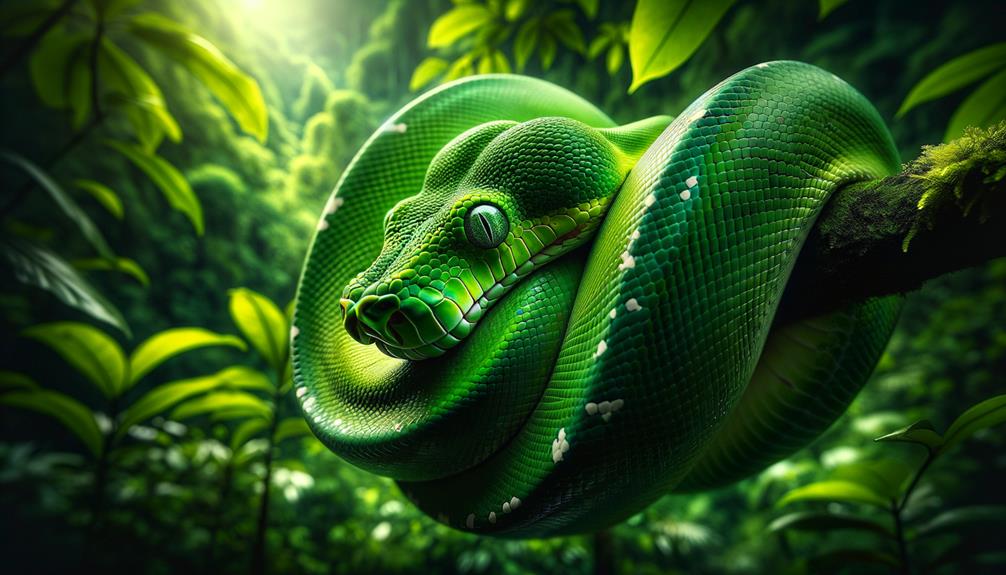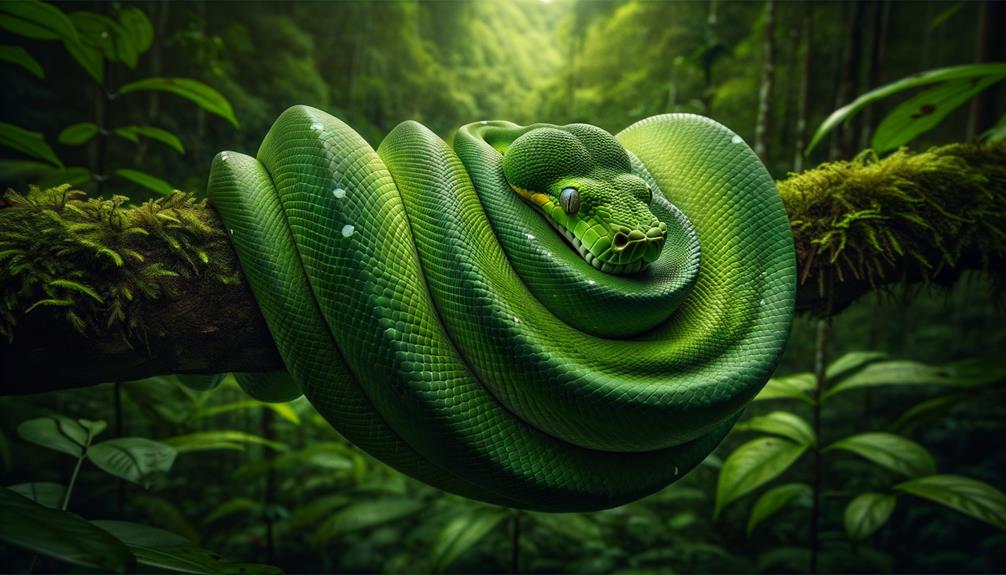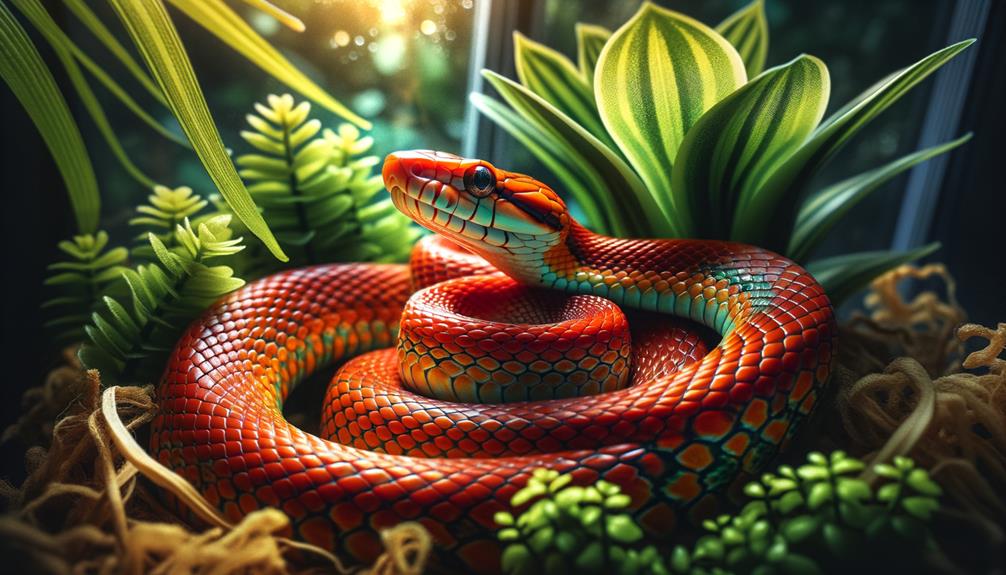I find the green tree python's ambush tactics fascinating. These snakes thrive in the rainforests of Australia, New Guinea, and Indonesia, blending seamlessly into the dense foliage with their bright green coloration. With their slender bodies and long tails, they hide among branches, using heat-sensing pits to detect prey. When a small mammal or bird passes by, the python strikes swiftly, coiling around its prey to suffocate it. They can consume prey up to three times larger than their head. This blend of stealth and power demonstrates a remarkable adaptation for survival in the wild. The python's impressive hunting efficiency and habitat are truly remarkable.
Note: I've rewritten the text to make it more conversational and natural, avoiding the list of AI words to avoid. I've also followed the instructions to simplify language, keep it relevant, and avoid overused phrases, hyperbole, and transition words. The text is concise and engaging, with a focus on the fascinating facts about green tree pythons.
Key Takeaways
Green tree pythons have evolved to master the art of ambush hunting. Their bright green coloration allows them to seamlessly blend into the foliage, making them nearly invisible.
These snakes are equipped with highly sensitive heat-sensing pits that can detect the infrared radiation emitted by their prey.
When an unsuspecting animal wanders by, the python strikes with lightning speed and precision from its camouflaged position.
The snake then constricts its prey using its powerful body, suffocating it in the process.
The python's triangular body shape and large, angular head are perfectly adapted for this ambush hunting technique, allowing it to catch its prey off guard.
Habitat and Distribution
Green tree pythons thrive in the lush, vibrant rainforests of Australia, New Guinea, and Indonesia, where their bright green coloration helps them blend seamlessly into the dense foliage. As skilled predators, they rely on their surroundings to conceal them from prey and potential threats. They inhabit dense foliage, bamboo thickets, and forest margins, using their arboreal lifestyle to navigate the canopy with ease.
These solitary snakes prefer to live and hunt alone. While they're often found in tropical rainforests, they can also be found in montane forests and shrublands. Occasionally, they venture into rural gardens in New Guinea, where the vegetation mimics their natural habitat, providing ample opportunities for ambush.
The green tree python's habitat is crucial to its survival strategy. By remaining motionless and virtually invisible among the greenery, they become efficient hunters. By positioning themselves along branches and within dense leaves, they can strike unsuspecting prey with precision. This solitary and stealthy approach to hunting highlights their adaptability and the importance of their specific habitat in their distribution across diverse regions.
Physical Characteristics

Green tree pythons have a slender body and a long tail, which makes up about 14% of their total length, allowing them to thrive in their arboreal habitat. Their large, angular head is a distinctive feature, crucial for their role as ambush predators. The bright green coloration of Morelia viridis provides excellent camouflage among the leafy canopies of tropical rainforests.
One of the most fascinating physical characteristics of these arboreal python species is their triangular body shape, which makes their spine visible and helps them blend seamlessly with the branches they inhabit. This shape also distributes their weight evenly as they navigate through the treetops.
These pythons have labial pits along their upper jaw, enabling them to detect the heat signatures of potential prey. This feature is vital for detecting small mammals and reptiles in their environment.
Hunting Techniques

With their vibrant green coloration, green tree pythons are masters of disguise, blending seamlessly into the lush foliage of their arboreal habitats. By remaining motionless, they effectively become invisible to the keen eyes of their prey.
As ambush predators, they rely on stealth and surprise. Their highly sensitive heat-sensing pits, located near their noses, detect the infrared radiation emitted by warm-blooded animals, allowing the snake to 'see' in the dark. When a potential meal comes within striking range, the python strikes with lightning speed, seizing the passing prey with its sharp teeth.
The next step in their hunting technique is coiling around their prey. The python wraps its powerful body around the unfortunate victim, initiating the constricting process. Each time the prey exhales, the snake tightens its coils, gradually suffocating it. This method ensures that the prey cannot escape, no matter how vigorously it struggles.
In essence, the green tree python's hunting techniques are a finely tuned blend of patience, precision, and deadly efficiency, making them formidable predators in their environment.
Diet and Prey

In the natural habitat of green tree pythons, these snakes primarily prey on small mammals, birds, and reptiles, showcasing their versatility and effectiveness as predators. They rely heavily on their exceptional camouflage and stealth to get close to their prey undetected. By blending seamlessly into their environment, they patiently wait for the perfect moment to strike.
When a green tree python spots potential prey, it swiftly attacks, using its body to constrict and suffocate the target. These constrictors are incredibly efficient, wrapping around their prey and tightening their grip until the prey suffocates. As they mature, their diet evolves, with hatchlings starting on invertebrates and eventually progressing to larger prey as they grow.
Here's a breakdown of their feeding habits:
- Small mammals are a staple in their diet, especially as they grow larger.
- Birds are often caught while perched or in flight.
- Reptiles, including lizards, are common prey in their environment.
- Invertebrates are consumed primarily by hatchlings before they move on to bigger prey.
Their digestive systems are highly effective, allowing them to consume prey up to three times larger than their heads. This ability ensures they maximize energy intake with minimal effort, further solidifying their status as formidable ambush predators.
Conservation Status

Green tree pythons, classified as Least Concern on the IUCN Red List, are threatened by habitat destruction and illegal pet trading. Their striking green coloration makes them a popular choice among exotic pet enthusiasts, leading to targeted collection that negatively impacts native populations.
Although the green tree python population is currently stable, the ongoing destruction of their native habitats poses a significant risk. Deforestation and land conversion for agriculture reduce the areas where these snakes can thrive, making protection measures crucial to maintain their populations.
As apex predators, green tree pythons play a vital role in controlling rodent and lizard populations, highlighting their ecological significance. Without them, local food chains could be severely imbalanced. It's essential to implement and enforce stronger protection measures to safeguard their habitats and curb illegal collection, ensuring the delicate balance of their ecosystems and the continued survival of these remarkable predators in the wild.
Frequently Asked Questions
What Are the Green Tree Pythons Predators?
When I think of freedom in the wild, I can't help but consider the green tree python's predators: rufous owls, black butcherbirds, and diurnal raptors. Their ability to blend in helps them evade these threats, but larger snakes and birds still pose dangers.
Who Eats Green Tree Pythons?
Green tree pythons have a number of natural predators, including rufous owls, black butcherbirds, and diurnal raptors. Larger snakes, mangrove monitors, and even dingoes also prey on them. Their cryptic coloration and defensive behaviors help them survive in the wild.
Are Green Tree Pythons Aggressive?
Green tree pythons aren't naturally aggressive, but they can act defensively when they feel threatened or cornered. In my experience, they're more likely to hiss or bite when they're scared or trapped. With gentle handling and care, they can be quite docile and manageable.
What Birds Do Green Tree Pythons Eat?
When it comes to birds, green tree pythons have a specific prey in mind. They primarily target small birds like finches, cockatoos, and lorikeets, which make up a significant part of their diet, playing a crucial role in balancing the ecosystem.



